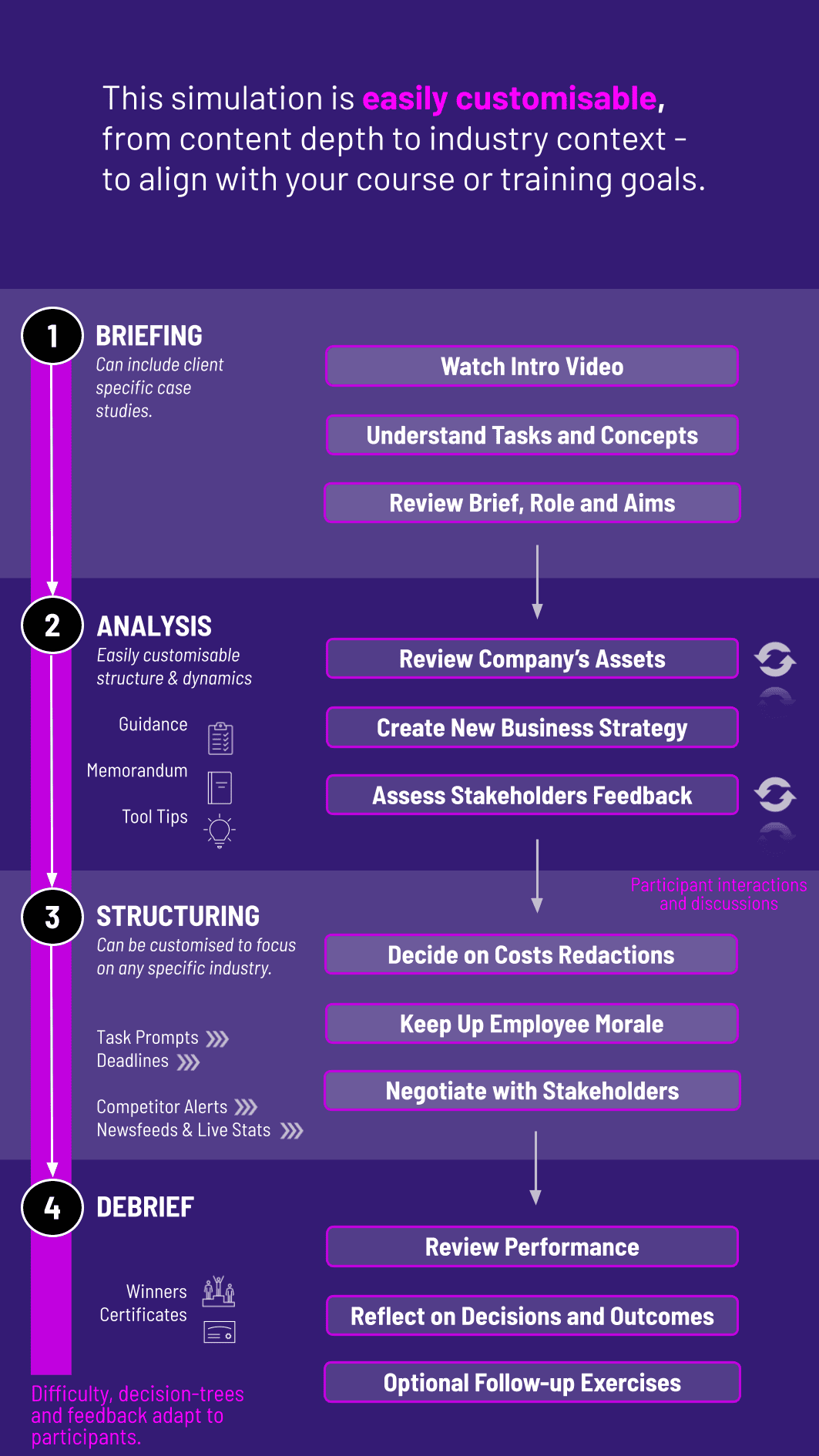
In this hands-on Digital Transformation Simulation, participants act as executives driving digital change - balancing innovation, culture, investment, and risk while adapting business models to disruptive technologies and evolving customer expectations.
Digital transformation strategy and roadmaps
Investment trade-offs in technology adoption
Customer-centric innovation and user experience
Cultural and organizational change management
Data-driven decision-making and analytics
Cybersecurity, compliance, and digital risk management
Agile vs traditional execution models
Disruption from fintech, AI, and platform businesses
Talent reskilling and workforce transformation
Long-term digital sustainability and scalability


Evaluate technology investments across AI, cloud, data, and automation
Balance innovation budgets with core business needs
Manage resistance from employees, managers, and boards
Redesign customer experiences through digital channels
Respond to competitive threats and disruptive entrants
Communicate transformation progress to stakeholders through board updates or press releases
By the end of the simulation, participants will be able to:
Design and execute digital transformation strategies
Balance innovation investment with financial stability
Navigate resistance and align organizational culture with digital goals
Evaluate risks and compliance in digital adoption
Apply data-driven approaches to decision-making
Understand customer behavior and digital expectations
Lead cross-functional collaboration in transformation projects
Respond strategically to disruption and competition
Communicate transformation strategies to diverse stakeholders
Reflect on leadership challenges in digital change initiatives
The simulation’s flexible structure ensures that these objectives can be calibrated to match the depth, duration, and focus areas of each program, whether in higher education or corporate learning.
This simulation works in both academic and corporate contexts and can be run individually or in teams. Each round simulates a phase of transformation - vision, execution, and scaling.
1. Receive a Scenario or Brief: Participants are introduced to a company under digital disruption, along with performance challenges and technology options.
2. Analyse the Situation: They review financials, customer trends, cultural barriers, and competitive benchmarks.
3. Make Strategic Decisions: Participants allocate budgets, prioritize technologies, and set transformation goals.
4. Collaborate and Align: Teams role-play as executives (CIO, CMO, COO) to negotiate and align decisions.
5. Communicate Outcomes: They deliver transformation updates to boards, employees, or the market.
6. Review and Iterate: Feedback shows financial results, cultural shifts, and stakeholder responses. Each round introduces new complexities.
Do participants need technical expertise? No. The focus is on leadership and strategy, not coding or technical skills.
Can it be customized for industries? Yes. It can reflect banking, healthcare, retail, manufacturing, or other industries.
Is it suitable for executive audiences? Absolutely. It’s widely used in executive programs to build digital leadership skills.
Does it include cultural change elements? Yes. Internal resistance, team morale, and culture shifts are central to the gameplay.
How long does it run? It can be a 2-hour exercise or a multi-day workshop.
Can it be run online? Yes. The simulation is designed for online, hybrid, and in-person delivery.
Does it include disruption scenarios? Yes. Competitor innovations, regulatory shocks, and customer shifts are built in.
Is customer-centricity part of it? Yes. Participants must design digital solutions aligned with customer needs.
Can universities integrate it into MBA programs? Yes. It fits well into MBA, executive education, and leadership development curricula.
How is success measured? Through digital adoption, financial results, stakeholder trust, and cultural alignment.
Quality of transformation roadmap and decisions
Balancing financial and innovation priorities
Handling resistance and stakeholder alignment
Clarity in communication and storytelling
Responsiveness to disruption and new technologies
You can also include memo writing and debrief presentations as part of the assessment structure. Additionally, you can also add a built-in peer and self-assessment tool to see how participants rate themselves. This flexibility allows the simulation to be easily integrated by professors as graded courses at universities and by HR at assessment centres at companies.
Join this 20-minute webinar, followed by a Q&A session, to immerse yourself in the simulation.
or
Book a 15-minute Zoom demo with one of our experts to explore how the simulation can benefit you.